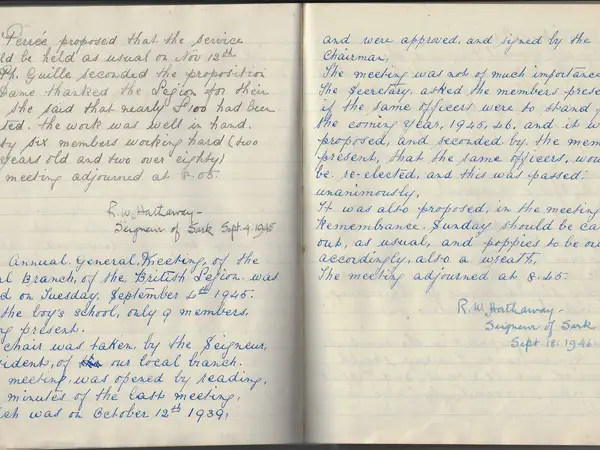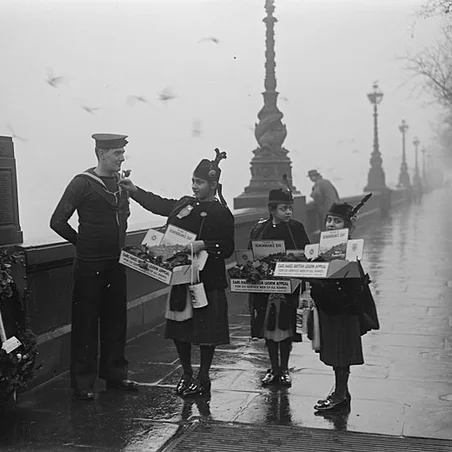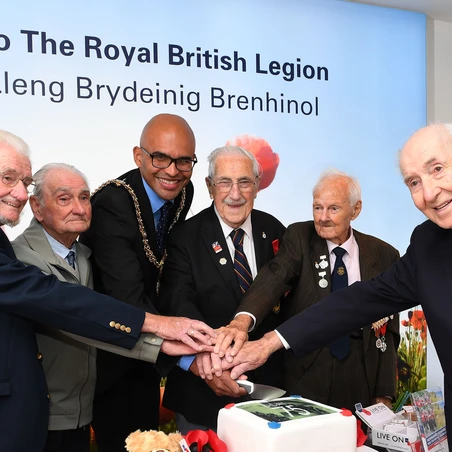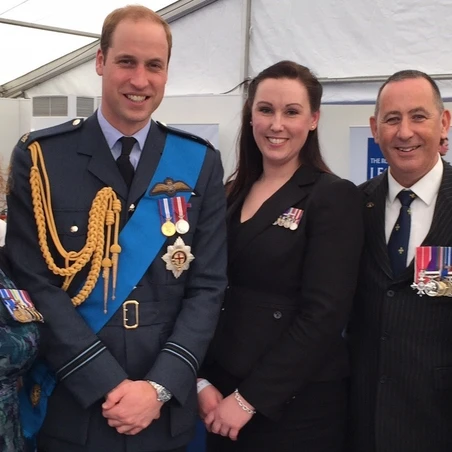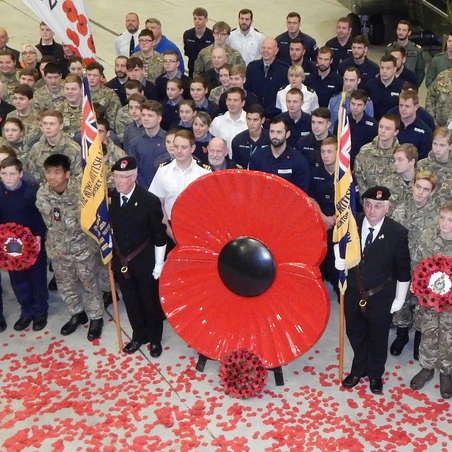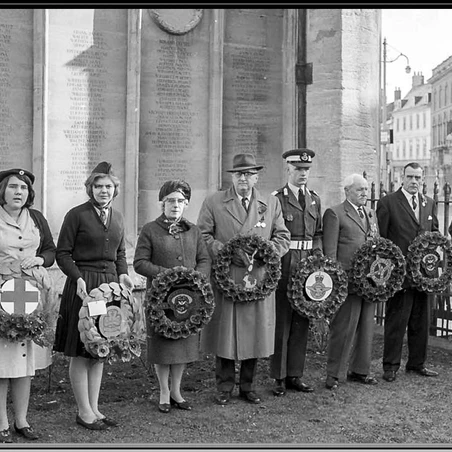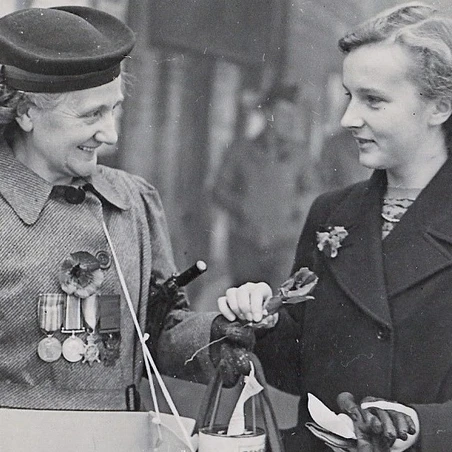RBL branches sit at the heart of communities and today there are approximately 2,500 across the UK.
Discover the stories behind our branches, from the challenges they have faced and the achievements they have accomplished to the dedicated members and how they serve their communities.

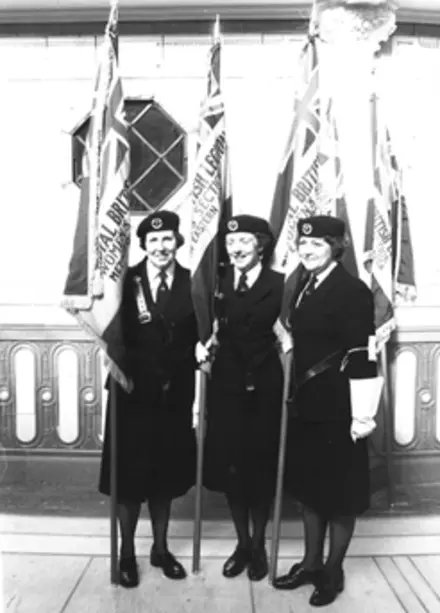

Women's Section
The British Legion Women’s Section was formed in 1921 to safeguard the interests of widows and families of ex-Servicemen and provide a way for women to be a part of the British Legion who were not permitted as regular members at that time. “You will not make a great organisation of this unless you bring your women in” said Earl Haig in 1923, realising their importance in the organisation.
Branches soon sprung up all over the UK and quickly became the driving force behind the Poppy Appeal whilst also raising impressive amounts of funds for their own benevolent work. Looking out in particular for the welfare of widowed women and children, the Women’s Section began programmes of pensions, clothing, rest homes and holidays to improve the wellbeing of those who had been affected by husbands and fathers serving in wars.
Today, members continue the traditions and work begun by their predecessors 100 years ago. Many members have had the honour of parading standards at the Festival of Remembrance or attending garden palaces in the company of Her Majesty the Queen and they continue to enjoy royal support with HRH Princess Anne as their President. The Women’s Section continues to raise vital funds for benevolent work within the Armed Forces community and provide a space for women to come together in support of the RBL.
*Images: Earl Haig meeting the Women's Section at the 1923 British Legion Whitsun Parade | Jennie Bailey with fellow Standard Bearers | Cowden Women's Section
.jpg?sfvrsn=5a708652_2&method=ResizeFitToAreaArguments&width=440&height=660&Signature=5FA9CD2DD41620AD4E867626767009CA1A671254)

.jpg?sfvrsn=5c22df90_2&method=ResizeFitToAreaArguments&width=440&height=660&Signature=31042978EF6CE3F1B76B4A77A228321920737FD2)
LGBTQ+ & Allies Branch
In 2018 the LGBTQ+ & Allies Branch of the Royal British Legion was formed. This was a momentous day, as it was the first branch of a veterans’ organisation aimed specifically at the LGBTQ+ community. Not wanting the branch to be totally exclusive, it also welcomes allies as members of the branch so that partners and family members of LGBTQ+ veterans or those who are supportive of the community can also join.
The branch was formally launched in January 2019, 19 years after the lifting of the ban on homosexuals in the UK armed forces, and now has 170 members. On the 20th anniversary of the lifting of the ban, the branch laid a wreath at the Cenotaph in London, to honour all servicemen and women who laid down their lives for their country and to remember those servicemen and women who identified as LGBTQ+.
London Pride 2019 marked a momentous occasion for every individual who participated. It gave members, staff and volunteers the opportunity to unite and take part in the Pride Jubilee which marked the 50th anniversary of the Stonewall riots. The newly founded branch was represented with the rainbow flag and Armed Forces personnel, who marched in their hundreds in uniform accompanied by the Central Band. Everyone ended the day feeling elated that the Armed Forces personnel were able to openly experience the parade in their service uniforms.
London Pride 2019
Crownhill branch, Devon
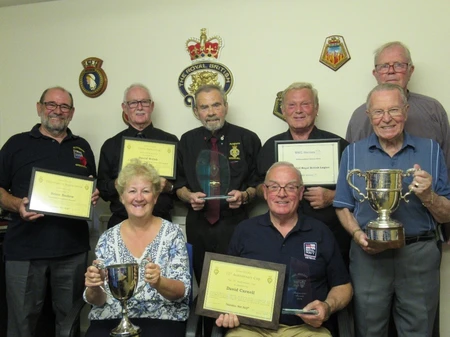
Winning the Haig Cup
The Plymouth Crownhill branch in Devon is a thriving branch of the Royal British Legion. The committee was honoured in 2018 by being awarded the Haig Cup, the highest award given each year at the National Conference.
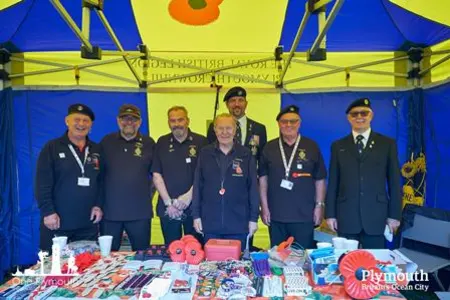
Part of a community
The branch has enjoyed a fantastic level of support and membership over the year with a current membership of over 1,400. This makes for wonderful social events and community integration.

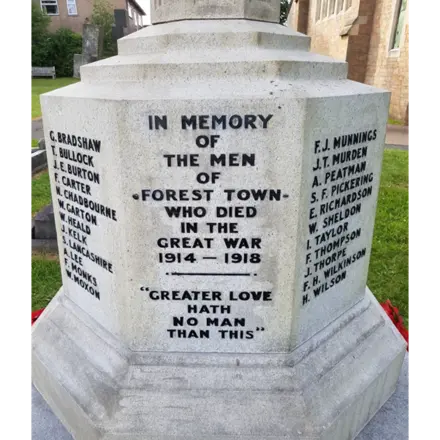
Clipstone and Forest Town branch honours the fallen
In 2015, Neil Davidson was elected as Chairman to the Clipstone and Forest Town branch. During the Remembrance Service at St Albans Church the following year he noticed several letters were missing from the inscription and names on the war memorial in the church grounds. Neil immediately resolved to refurbish the memorial as a priority.
The community were supportive of the appeal and funds were raised quickly. The branch members pulled together to clean the Memorial before the Stonemason could replace the missing letters and repair it. The local college also made metal railings to go around it to stop the wreaths from blowing away.
A rededication
service was held in 2017, which involved the local community and several family
members of those named on the memorial. After a short service in St Albans
church a wooden Remembrance cross was laid on the memorial for each of the
fallen. The branch and local community came together to
ensure that we continue to honour those who died.
The National Memorial Arboretum branch
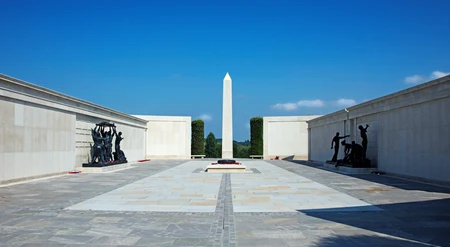
National Memorial Arboretum
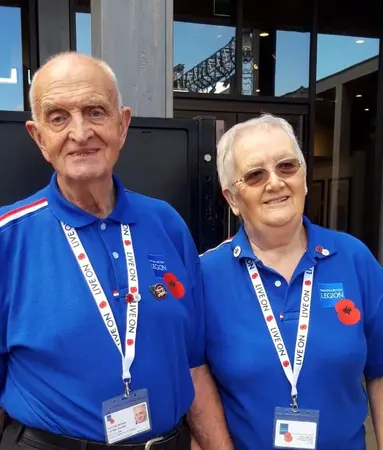
Ray and Diana Millington
Ray and Diana Millington volunteered at the NMA before then joining the branch.
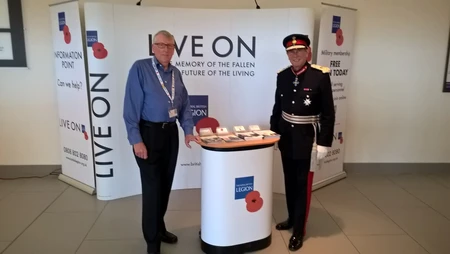
Outreach volunteer, George Martin
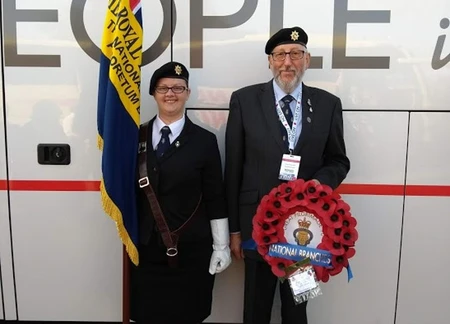
Military Members
The branch also engages with military visitors to the NMA to ensure that they are aware of what support is available and encouraging Military Membership to the RBL, signing up almost 6,500 Military Members.
Staple branch established in 1926
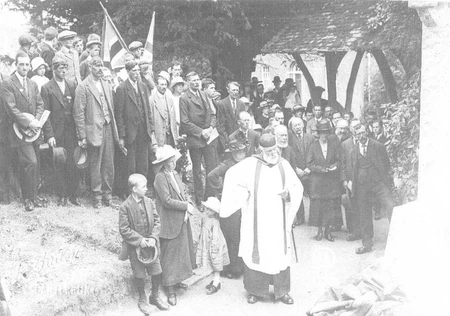
A First World War memorial was made by a Sandwich Stonemason and erected in August 1921. Seven names were inscribed on the Memorial, two of them brothers. For a small village of mostly agricultural labourers this was a heavy loss.
Starting the Staple branch
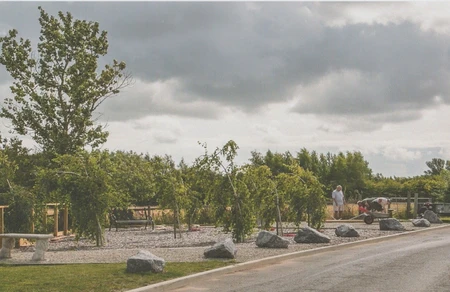
The Lost Sons of Staple
In 2014, the branch wanted villagers to really know the young men who had given their lives in the wars, referred to as “The Lost Sons of Staple”. A Garden of Remembrance was built with a memorial stone and nine smaller stones - for each “Lost Son” - along with nine silver birch trees. Each year a wreath is laid in the garden on Remembrance Day and the garden has become a focal point for the close-knit community.
Cowden, Hartfield and District Branch
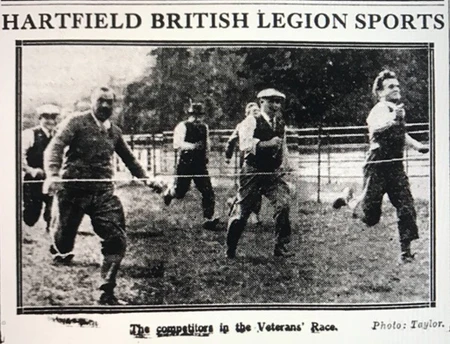
The Hartfield Branch
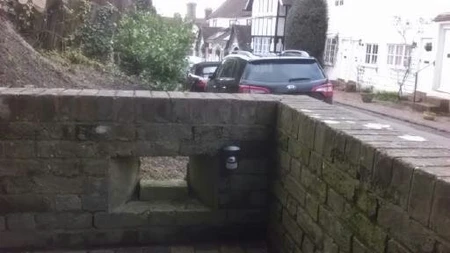
In 1936, the branch began working with the British Red Cross to support air raid wardens as the fear of another war loomed.
The Legion hall also had a loophole made in the staircase wall for a Bren gun to be positioned should an invasion occur. In this event the branch members, many part of the Home Guard, would make their ‘last stand’ at their hall.
Preparing for War

Hartfield branch soon had a surge of women wanting to join, and in 1936 the Women’s Section recorded a membership of 125 people - more than three times the number of the Cowden branch when it opened two years later.
On 17 November 1994, it merged with the Cowden Branch in Kent and became the Cowden, Hartfield and District Branch.
The Women’s Section and Cowden Branch join the Legion
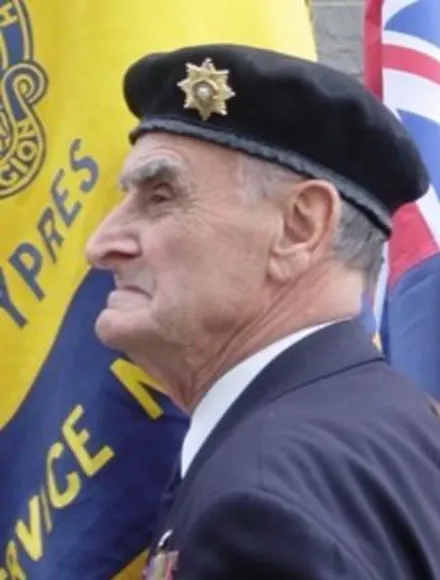
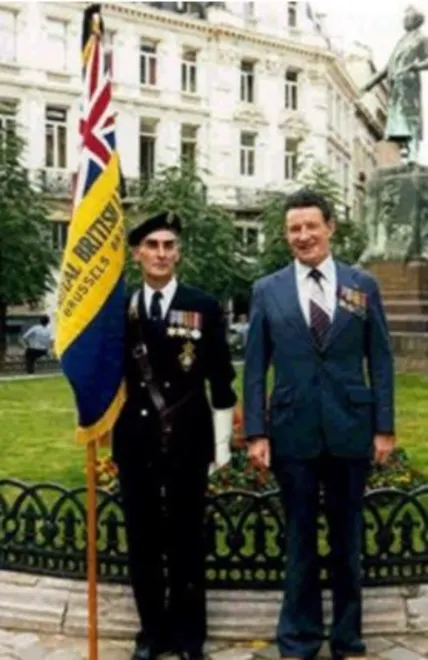
Eric Johnson (BEM)
Standard Bearer Eric Johnson was awarded the British Empire Medal (BEM) in the 1990 Queen’s Birthday Honours List in recognition of his services to British interests in Belgium.
He was presented with the medal on 9 March during a special ceremony in Brussels. Eric ‘retired’ as a Standard Bearer in March 2001, but was back on duty at the Evere Commemoration at Brussels Cemetery on 30th June that year, after his would-be successor was unfortunately hospitalised.
He continued in the role, receiving a veteran’s badge in commemorations on 8 May 2005 and the Voluntary Service Medal in November 2008 in recognition of more than 50 years of service to the Brussels Branch. The citation read: “Eric sets an example to us all with his enthusiasm, immaculate turn-out, and charming spirit. He always makes time to chat to everyone. In fact, he makes it his job to get to know them, whether a new member, an old member, or even children who turn up to events from time to time. A better representative we couldn’t, and indeed do not, have.”
After 56 years of making the job his own, Eric Johnson made what would be his final appearance as Standard Bearer during the annual commemoration at the Commonwealth War Graves Commission cemetery in Evere, Brussels on 23 June 2012.
*Images: Eric Johnson with Harold Moffat in Liberty Square, Brussels in 1979 | Carrying the standard at the GP90 event in Ypres
Darlington Branch’s Acts of Remembrance
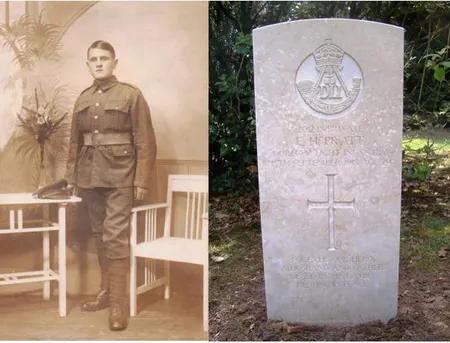
Edward joined the Durham Light Infantry and was deployed to France in February 1916. In March of that year he suffered gunshot wounds to his leg and neck. He was given just three months to convalesce before returning to France in June 1916 where he was wounded once again.
In March 1917, the trench Edward was occupying was bombed leaving him half buried, suffering a brain injury and partial paralysis. For the final time, he returned home in November 1917. Sadly, Edward eventually succumbed to his injuries and died in September 1918, aged 29.
Honouring Edward Henry Pratt

Another such act of Remembrance was for Pilot Officer William McMullen, a Canadian Airforce airman. On 13 January 1945, he was battling with his burning Lancaster Bomber above Darlington. His six crewmates bailed out, but McMullen stayed with the stricken aircraft, guiding it away from nearby houses and crashing into a field at Lingfield. We shall never know how many lives he saved.
Since 1995, the branch has gathered on the spot of McMullen’s crash to reflect and remember his selfless act and extraordinary courage. In 2020, the battered and bent propeller from McMullen’s plane was returned to the scene.
Honouring William McMullen
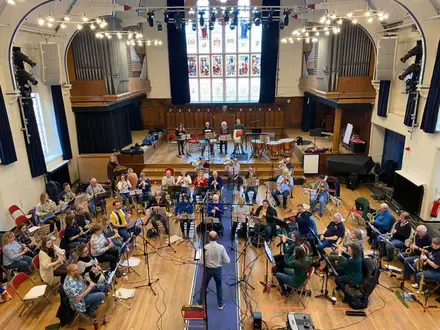
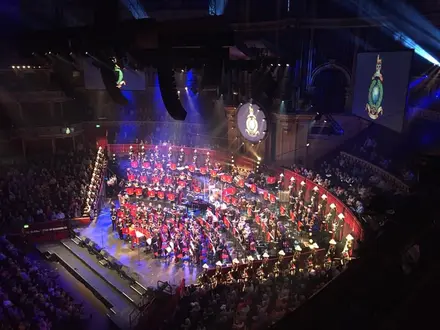

A brief history of The Central Band of The Royal British Legion
In
1944, a group of musicians sat in the bar of the British Legion Club in Epsom.
They had all been members of the 56th (Surrey) Battalion, Home Guard which had
recently been stood down, bringing four years of comradeship to an end. They resolved
to form a new band under the British Legion and were immediately offered the
use of an upstairs room at the club for weekly rehearsals. Starting with
nothing, it took them 10 years to raise the funds for their uniforms. A
second-hand music library was acquired together with some old and battered
music stands, and they recruited some demobbed musicians. By 1948 they’d transferred
to another Legion branch in Epsom which offered a hall. The Home Secretary, Right
Honourable J Chuter Ede, became the band's first President.
In
1949, the band won first prize at the Berkshire and Neighbouring Counties Band
Festival at Reading – the first of many grand performances that led to the
band’s glittering reputation known by so many today. 1965 saw the beginnings of
a 13 year association with West Ham United Football Club where the band
provided music for all home matches. One memorable day, as the musicians marched
off the field after half time, a disgruntled supporter yelled ”You best stay on
mates, you can't do worse than our lot”.
In 1970 the band won a gold medal in the prestigious World Music Contest in Holland, earning them the status of 'Metropolitan Area Band', which was a recognition by the RBL of the important role bands play in publicising the charity’s work. The band visited the famous Abbey Road Studios in 1973 to make its first recording; a compilation of marches, hymns and incidental music designed for use by RBL branches unable to afford a band for formal or ceremonial occasions. A second record was made in 1981 and the band has been a regular visitor to the recording studios ever since.
In 1983, the RBL
band was granted the title of the ‘National Band’ which was changed three years
later to the Central Band of the Royal British Legion.
Since then, the Central Band of the Royal British Legion has gone from strength to strength and 2021 sees it enter its 77th year of music making at the highest level in support of the Royal British Legion. The Band has entertained D-Day veterans on the Boudicca, performed at Bayeux with Rod Stewart and at the Festival of Remembrance, worked with Alfie Boe, Laura Wright, the Bach Choir, Max Bygraves, Liberace and Harry Secombe. All the members of The Central Band are volunteers who readily give their time to support the Royal British Legion. Many past and present players have served in the Armed Forces and are led by RBL’s renowned Director of Music, David Cole.
*Images: Band rehearsing at the St Danstan's College | Central Band | Bandstand at Eastbourne.
Members

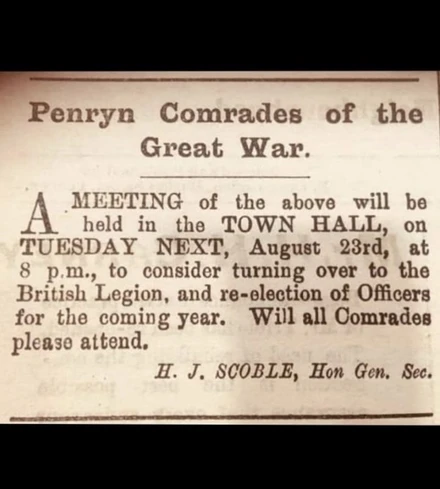
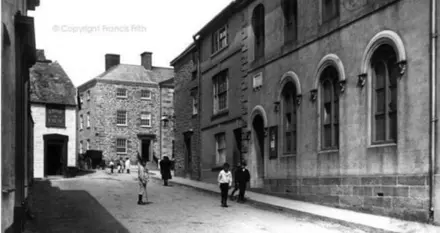


Penryn branch history
In Penryn, Cornwall, the ex-Service community formed one of the first branches of the Comrades of the Great War under the command of Captain Noel Blamey and began helping military families. On 23 August 1921 a meeting was held to change the organisation into a branch of the British Legion.
In 1922 the branch were very active in the community. They erected a war memorial, established a playing field for local children and set up a Distress Committee for ex-servicemen. In November 1922 the branch raised £34.13 (almost £2000 today) at the first Poppy Appeal. By 1925, there was also a Women’s Section.
Throughout the 1920s and 30s the branch headquarters were in the Church Institute at Quay Hill. During this period, the branch - and in particular the Women’s Section - held fundraising events including the Old Age Pensioners Annual Tea & Concert; the Hospital Linen Fund; the Ambulance Fund; the Royal Cornwall Girls Home Fund; and Maternity Bags full of donations to help new parents in the area.
In 1941, the Church Institute was destroyed in an air raid along with all the branch’s records. Eighteen people were killed including the Hon. Secretary. That year the branch raised £108 4s 8d (over £5,000 today) for the Poppy Appeal.
Following the end of the Second World War the branch carried on its community work throughout the 1950s to the present day. Since the loss of the Legion Room at Quay Hill, the branch has had no fixed abode and has met significant challenges over the years. Despite these drawbacks, in 2010 the Penryn branch raised almost £20,000 for the Poppy Appeal - one of the largest amounts in Cornwall.
In the coming year we hope that the branch will be able to build up its membership so that they can carry on the work of its incredible predecessors, and honour those who served and died so what we may live.
*Images: Portrait image of Captain Noel Blamey | Newspaper invite of first Penryn meeting | The Church Institute- now the site of the Memorial Gardens, Penryn | Newspaper article about Penryn celebrating VE and VJ Day in 1945 | The visit of HRH Princess Anne - Penryn's 750th Anniversary of the granting of the Charter Legion branch forms guard of honour the Memorial Gardens on 20 May 1986.
Branches
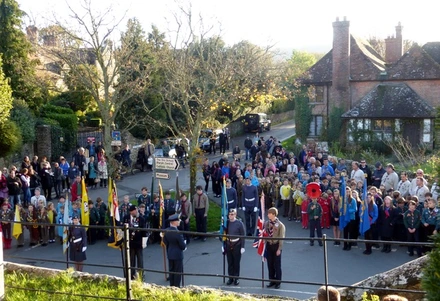
Storrington branch history
In 1919, following the end of the First World War, Captain George Graham chaired a meeting of 70 veterans to establish the Association of Comrades. They would raise welfare funds to care for the village’s ex-servicemen, widows and their dependants.
The meeting concluded with the veterans marching through the village.
In 1920, donations from residents and the Peace Celebrations Committee allowed the Association to purchase ground on which they built a hut, serving as the Association of Comrades’ headquarters. Following an Armistice Day opening with a guard of honour and church parade, the club flourished due to its prolific fundraising events and its role in awarding benefits to the local Armed Forces community. In 1921 it became a prevalent branch of the Royal British Legion, growing from 70 founding members to 401 following the Second World War. The HQ still stands today.


.jpg?sfvrsn=1a2e79f_2&method=CropCropArguments&width=600&height=450&Signature=E2C04B6270D36544F7686CDD90208DDF3AE3F81B)
.jpg?sfvrsn=71053da_4&method=CropCropArguments&width=600&height=450&Signature=00B21C9C902D8450F44D58128FC7098FA1903897)
